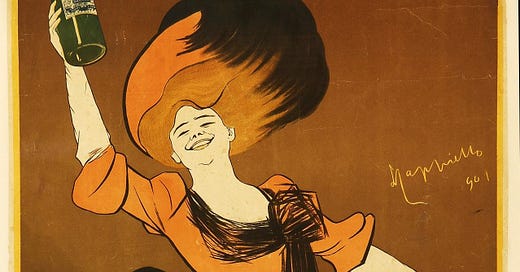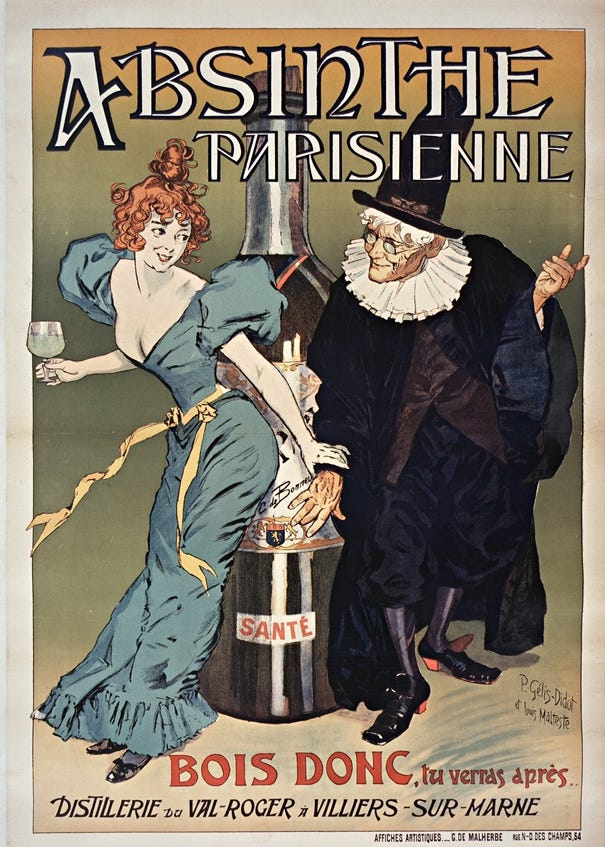Recently, I wrote about some of the well-known cafes in the Pigalle/Montmartre areas of Paris during the second half of the 19th century and into the 20th. They were the backdrop for lively discourse, especially among artists, writers, and respected newspaper editors.
Some of the books I read through made a small but notable mention of one thing that was popular at the time: absinthe.
Absinthe comes from a plant called artemisia absinthium, or wormwood leaves. Way back in history (ancient Egypt and Greece), wormwood was used as a medicine to treat anything from anemia to rheumatism to a fever or stomachache. In the 18th century, a doctor in Switzerland distilled wormwood with anise, fennel, and other herbs to create the strong elixir. In the 1840s, French soldiers in Algeria used it to prevent malaria, but they also discovered that it made a very potent cocktail. When the soldiers returned home, they introduced France to the powerful green liquid, and it slowly gained in popularity.
In the earlier days, absinthe became the favored drink among the upper echelons of Parisian society and later trickled down. By 1849, there were 26 distilleries in France. Absinthe earned the nickname la fée verte, or the green fairy, owing to its color. It was said to have hallucinatory effects (including psychosis - yikes) with an extraordinary alcohol content of around 68%!
Some writers and poets sitting in those Montmartre cafés enjoyed drinking absinthe, and the neon green drink became the muse of many creatives like Paul Verlaine, Arthur Rimbaud, Charles Baudelaire and, of course, Henri de Toulouse-Lautrec. Drinkers would enjoy ‘the green hour’ when it was time to crack open a bottle.
Here’s a terrific this description of the absinthe drinkers who’d appear on the doorsteps of various cafés in Paris, from Alfred Delvau’s Les Heures Parisiennes (1866).
…the ‘absinthers’ would arrive as was their daily habit. Don’t be fooled into thinking these were people from the Pont-Neuf [area of Paris]. This one works for the railway in Orleans, this one is a dispatcher for the ministry of finance, one was a law student… a medical student… an aspiring journalist.
[An aside: I have no idea what he meant by ‘people from the Pont-Neuf’ but I did a little research out of curiosity. The only reference I found was a quote in The Count of Monte Cristo in which Alexandre Dumas describes the Passage du Pont Neuf, a dark and sinister place during the day and at night. Perhaps at the time it was known as a place for unsavory activities? I digress…]
In the following decades and into the 20th century, other famous scribes would come to enjoy drinking the neon liquid, like Ernest Hemingway and James Joyce.
The Irish poet and writer Oscar Wilde, who died in Paris in 1900, famously wrote about absinthe:
After the first glass, you see things as you wish they were.
After the second, you see things as they are not.
-Oscar Wilde
There were even songs written about the drink, like the one below from 1903:
Artists depicted the highs and lows of absinthe drinking, as it took a hold on French society. Below is a sketch by Édouard Manet called The Absinthe Drinker (Le Buveur d'absinthe) from 1862. The man’s top hat gives the impression of a possible aristocrat, but he’s actually a rag-picker who was addicted to absinthe. Manet produced a painted version of this image in 1859 and submitted it to the Paris Salon (a very prestigious showcase of the best art of the day). However, it was rejected because it showed a less savory side of Paris life.
I also found many lively advertising posters from French absinthe producers depicting people dancing, laughing, and in one case, a devilish green character popping open a bottle:
Alas, what seemed like one great big green party ended up coming to an end as the effects of absinthe started to root their ugly head. People became addicted to it, and conservative society and prohibitionists singled it out specifically for causing human misery and destruction.
Here’s a great illustration of absinthe’s hold on people - it’s a movie poster from 1911 entitled Les Victimes de l’Alcool:
If you like old silent films, you can actually watch Les Victimes de l’Alcool here.
Depictions of absinthe’s negative effects also showed up in print publications, like this one entitled “Paris sketch: I’m jealous of your absinthe. You love it more than me.”
As with many things of this nature, something had to be done about the growing concern over absinthe’s effects. It took a while, but France finally banned it in 1915, following Switzerland, Belgium and the Netherlands. Below is a photo of the poster from the local police in Paris announcing the ban (sorry it’s blurry).
Over the last 30 or so years, absinthe has seen something of a comeback. Changed laws under the European Union made it so absinthe could be produced and sold again, including in France. I don’t know anyone personally who drinks it, so I’m not sure how popular it is. But the spirit — pun intended — of la fée verte makes for very good stories from vieux Paris.
Sources:
Affiches sur l'Absinthe: Musee Virtuel de l'Absinthe - Le Monde des Antiquités d'Absinthe
BnF Gallica blog about absinthe
The Devil in a Little Green Bottle: A History of Absinthe | Science History Institute
Absinthe | Scientific American













Another great one Jenn, I look forward to these now...Keep writing
Until recently there was a very classy absinthe bar in Pigalle with tasting flights of various absinthes and absinthe based cocktails. Unfortunately closed a few years back, there are a few others but haven’t tried them